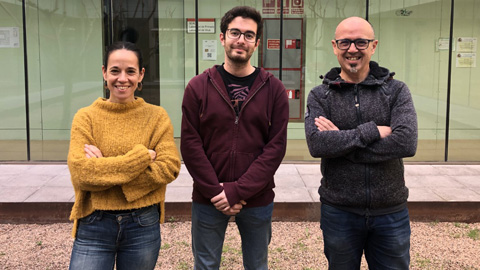New research hypothesis to find novel treatments for Parkinson's disease

Researchers from the IBB and the Department of Biochemistry and Molecular Biology recently published an article in Trends in Biochemical Sciences proposing a new research line for the study of Parkinson’s disease, based on the identification of human endogenous peptides that selectively block the toxic aggregates causing the disease, and which could lead to the development of innovative treatment alternatives to prevent cognitive decline.
24/02/2022
In 2021, a UAB research team led by Salvador Ventura, researcher at the Institute of Biotechnology and Biomedicine (IBB) and at the Department of Biochemistry and Molecular Biology, identified LL-37, a human peptide with one of the highest described capacities to block the formation of toxic alpha-synuclein (aSyn) protein aggregations and the neurotoxicity associated with Parkinson’s disease. With a potency similar to that of an antibody, the molecule also has the ability to block toxic oligomers selectively, without affecting the functional form of the protein.
The discovery of LL-37 has led Salvador Ventura, Irantzu Pallarès and Jaime Santos to pose a new research hypothesis: the existence of a repository of endogenous molecules with an activity similar to that of LL-37, which thanks to an increase in their levels of expression, could open the door to an innovative approach for the development of new therapies to fight Parkinson’s disease and other synucleinopathies. Researchers presented their proposal in the article “Is a cure for Parkinson’s disease hiding inside us?”, published under the Forum section of Trends in Biochemical Sciences, belonging to the group Cell.
“Human cells produce a myriad of endogenous peptides, whether that be as bioactive molecules or as subproducts of protein processing and degradation. It would not be strange for a group of them to participate in blocking activities similar to what LL-37 does and that our organism is already coding molecules which protect against Parkinson’s. If this deposit of endogenous peptides exists, it may constitute a game changing therapeutic target for disease-modifying approaches in Parkinson’s disease”, the article points out.
The block of aSyn oligomers to neutralise the advance of Parkinson’s disease is one of the most promising therapeutic strategies existing today. At structural level, these oligomers consist of a rigid nucleus surrounded by an external, disorderly and dynamic fuzzy coat. The study of the specific properties found on the surface of the oligomers suggests that the fuzzy coat actively participates in its cell-to-cell aggregation, toxicity and propagation, offering an opportunity to block them selectively. It was the use of this strategy that led UAB researchers to identify LL-37.
This new strategy to block oligomers may have great therapeutic potential, the researchers state. Ventura, Pallarès and Santos propose that an increase in the levels of expression of LL-37 and other similar peptides may neutralize the toxicity of aSyn oligomers and their propagation. According to researchers, the strategy has already been proposed for anti-microbial peptides and the results are promising.
“The expression of LL-37 in humans is regulated by a variety of natural substances, among which are vitamin D and butyrate, and some studies have related them with an improvement in disease symptoms in humans and animal models. Although cause and effect has not yet been established between these two activities, it is tempting to propose that this connection may respond to a modulating role of the LL-37’s activity in the advancement of the disease. If this were confirmed, the oral administration of a cocktail of natural substances added to one’s diet capable of regulating the expression of specific endogenous peptides could be a safe and potentially prophylactic treatment certainly worth investigating”, Salvador Ventura explains.
The UAB researchers have already patented LL-37. Their objective now is to obtain the resources needed to validate their hypothesis, which they describe as “bold, but also groundbreaking and promising”.
Article: Jaime Santos, Irantzu Pallarès, Salvador Ventura. Is a cure for Parkinson’s disease hiding inside us? Trends in Biochemical Sciences, 2022. https://doi.org/10.1016/j.tibs.2022.02.001.
Related news: Human molecule able to block the toxic forms of the protein triggering Parkinson's disease identified